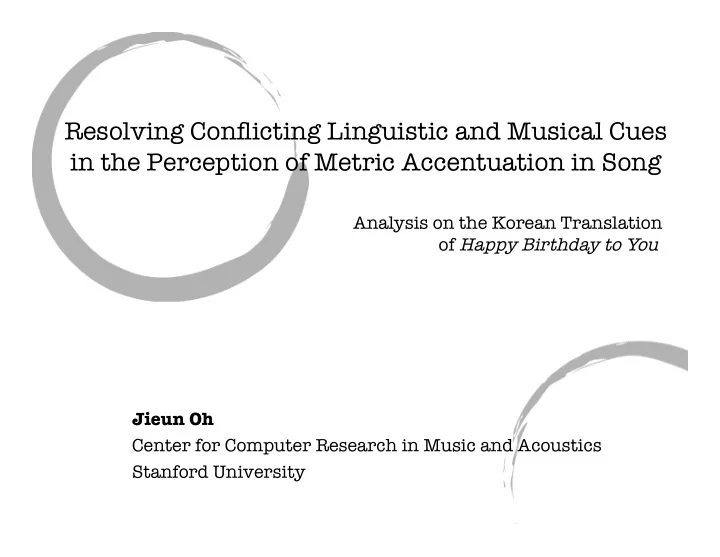

Resolving Conflicting Linguistic and Musical Cues in the Perception of Metric Accentuation in Song Analysis on the Korean Translation of Happy Birthday to You Jieun Oh Center for Computer Research in Music and Acoustics Stanford University
On the interplay of accentuation in language and in music From Dell and Halle (2005) lyrics (text) vs. melody (tune) 2
Typical resolution of conflict : � Tune > Text Mang, E. (2007) Pitch information for Chinese Ross, J. (2003) Rhythmic information for Estonian 3
Atypical resolution of conflict: � Text > Tune Morgan, T. & Janda, R. (1989): “Frère Jacques” (1) Original lyrics (2) mismatched (no subjects) (3) Most common resolution Korean translation of “Happy Birthday” 4
5
“Happy Birthday to You”: English vs. Korean Phrases 1, 2, 4: HAP-py BIRTH -day to YOU Phrase 3: HAP-py BIRTH -day dear SA -RAH Phrases 1, 2, 4: SENG -il CHU-kah HAP -ni-da Phrase 3: SA -rang HA-neun JI -EUN-e-eui 6
Experiment: � Syllabic Intensity Tracking through Finger Tapping Objective finger tapping Anacrusis/ downbeat perceived intensity while singing perception contour of syllables Equipment & Setup Computer acoustic MOTU Praat running Audacity drum trigger audio interface for analysis 7
Subjects 12 Native English speakers with no knowledge of Korean (Group I) 18 Korean-English bilinguals (Group II) Complete fluency Complete fluency in English in Korean Group I Group II_1 Group II_2 Group II_3 Group II_4 (n=12) (n=5) (n=5) (n=6) (n=2) 8
Hypothesis Perceive Perceive Downbeat Anacrusis (1) ACROSS-GROUP singing in English Native English Speaker Native Korean Speaker (Offline effects) (2) WITHIN-SUBJECT by a Kor-Eng bilingual Sing in English Sing in Korean (Online effects) 9
Task Part 1: Short Questionnaire Part 2: Perform in subject’s primary language (Group I & II) [1] sing (“la”) [2] sing (“la”) + tap [3] recite (actual lyrics) [4] sing (actual lyrics) [5] sing (actual lyrics) + tap Part 3: Perform in subject’s secondary language (Group II only) Identical to Part 2, except with secondary language Part 4: Final Survey 10
Summary of Analysis Procedure 1. Record 5 trials per subject-language 2. Match tap intensity peaks to the syllables in the text 3. Calculate the change in intensity (as ratio) between consecutive syllables: 4. Determine RatioA and RatioB RatioB E = " you " ⎛ ⎞ ⎛ ⎞ " py " " birth " ⎟ = " birth " RatioA E = ⎜ ⎟ ⎜ " to " " hap " " py " " hap " ⎝ ⎠ ⎝ ⎠ ⎛ ⎞ ⎛ ⎞ " il " ⎛ " chu " ⎞ ⎟ = " chu " " ni " ⎛ " da " ⎞ ⎟ = " da " RatioA K = RatioB K = ⎜ ⎜ ⎜ ⎟ ⎜ ⎟ " seng " ⎝ " il " ⎠ " seng " " hap " ⎝ " ni " ⎠ " hap " ⎝ ⎠ ⎝ ⎠ 11
Result: Across Group comparison over Pattern A 12
Result: Within-Subject comparison over Pattern B Within-Subject Comparison of RatioB ("you"/"to") Sing in English Sing in Korean 2 1.8 Median Intensity Ratio (n=15 per subject) 1.6 1.4 1.2 1 0.8 0.6 0.4 0.2 0 13 14 15 16 17 18 19 20 21 22 23 24 25 26 27 28 29 30 II_1 II_2 II_3 II_4 Group II Subjects (n= 5+5+6+2= 18) 13
Conclusion Perceive Perceive Downbeat Anacrusis (1) ACROSS-GROUP data over Pattern A: Native English Speaker Native Korean Speaker (2) WITHIN-SUBJECT data over Pattern B: Sing in English Sing in Korean 14
Music & Language: Research Implications Song’s 1. Lyrics Perception of Metric Accentuation 3. Singer’s Language 2. Proficiency 1. online effects of lyrics on metric perception of songs 2. offline effects of L1 when singing in L2 3. language fluency may affect the extent to which linguistic stress patterns play a role in the overall beat-strength perception of songs. Language can play a significant role in the inference of beat accentuation (and by extension, the metric perception) of songs 15
Thank you Acknowledgment - Jonathan Berger (thesis advisor) Professor of Music, Stanford University - Lera Boroditsky (second reader) Professor of Psychology, Stanford University Research Funding - Major Grant, awarded by the Stanford University Undergraduate Research Program 16
Selected References Dell, F. & Halle, J. (2005). Comparing musical textsetting in French and in English songs to appear in proceedings volume from the first international Paris conference on the typology of metrical forms. Mang, E. (2007). Speech-song interface of Chinese speakers. Music Education Research , 9(1), 49-64. Morgan, T. & Janda, R. (1989). Musically-conditioned stress shift in Spanish revisited: empirical verification and nonlinear analysis. In Carl Kirschner, and Janet Ann DeCesaris (eds.) Studies in Romance Linguistics , Selected Proceedings from the XVII Linguistic Symposium on Romance Languages. New Jersey: Rutgers. Ross, J. (2003). Same words performed spoken and sung: An acoustic comparison. Proceedings of the 5 th Triennial ESCOM Conference , Hanover University, Germany. 17
Recommend
More recommend